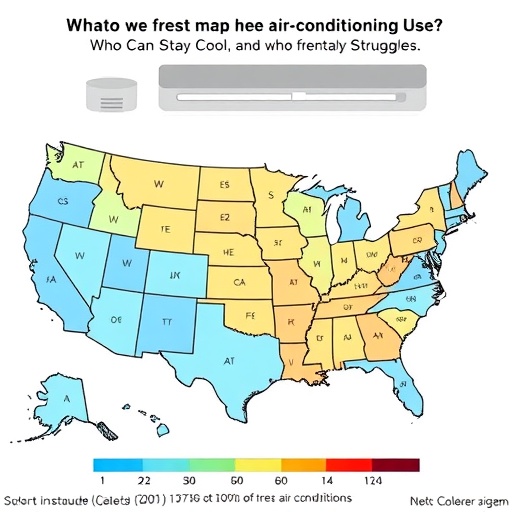As the frequency and intensity of heatwaves escalate due to climate change, the question of adequate home cooling in the United States becomes increasingly urgent. A pioneering study led by Yoonjung Ahn, assistant professor of geography and atmospheric science at the University of Kansas, addresses this critical issue by producing the most comprehensive and spatially detailed map of air conditioning (AC) usage across the nation. This groundbreaking dataset aims to revolutionize how public health officials, urban planners, emergency responders, and policymakers understand and respond to disparities in cooling access amid rising temperatures.
The research, published in the peer-reviewed journal Scientific Data, fills a significant gap left by traditional data sources which measure AC ownership and types only on broad scales or limited samples. Prior datasets like the American Housing Survey provide information at county or metropolitan levels and often rely on surveyed locations, while the Energy Information Administration’s data only sample subsets of the full population. Professor Ahn’s novel approach integrates spatial modeling, advanced statistical methods, and big data analytics to generate a nuanced picture of cooling infrastructure down to the census tract level.
Central to this research was the use of Dewey’s comprehensive real estate dataset, which offers household-level insights spanning the entire country. By combining this with known predictors such as housing type, building age, renovation dates, racial and ethnic demographics, historical housing policies, and prevailing climate conditions, the study constructed a highly granular framework to infer air conditioning presence and classification. To resolve data gaps, the research team employed sophisticated machine learning algorithms including random forest for imputing missing values and the XGBoost classifier for categorizing homes by AC type: central systems, window or portable units, evaporative coolers, or none.
The results revealed previously obscured spatial and sociodemographic patterns in cooling access. Urban and rural differences emerged sharply—rural areas of Oregon, for example, showed a prevalence of central air conditioning alongside evaporative coolers, while urban centers displayed greater diversity in AC types including a significant proportion without any form of air conditioning. Florida’s households demonstrated stark contrasts; around 20% relied on non-central air conditioners whereas in urban areas central AC dominated with over 95% ownership. Such detailed insights are invaluable for pinpointing vulnerable populations during heat events.
One of the most compelling aspects of this dataset is its revelation of how socioeconomic and demographic factors influence air conditioning ownership. Climate and heating types unsurprisingly act as the strongest predictors, but ethnicity also plays a substantive role. Households in regions with higher Hispanic populations, such as parts of California and New Mexico, are notably associated with higher use of evaporative coolers and other non-central AC types. These distinctions underscore the intersection of climate, economics, social equity, and infrastructure, raising important questions about energy justice and health disparities in a warming world.
Despite the dataset’s comprehensiveness, Professor Ahn acknowledges its limitations and the challenges inherent in compiling such nationwide data. High proportions of missing information in metropolitan areas like New York City add uncertainty, partly because local housing characteristics such as older building stock and income variability defy broad model assumptions. Additionally, the dataset captures contemporary conditions only, lacking historical depth that could shed light on longstanding trends and shifts in cooling technologies over time.
The researcher also highlights the inadequacies of self-reported data from traditional surveys, where discrepancies between reported and actual AC usage are common. Portable or swamp coolers may be overlooked or underreported despite their significant role in providing relief from heat, particularly in certain climates. By integrating multiple data streams and employing machine learning to correct these biases, this study sets a new standard for precision in environmental and public health data.
Beyond academic knowledge, this research provides tangible tools for diverse stakeholders. Public health officials can identify heat-vulnerable regions lacking effective cooling, enabling the design of targeted outreach and assistance programs. Urban and rural planners can tailor infrastructure investments to meet localized needs and optimize energy efficiency. Energy auditors and private industry players can promote affordable, climate-appropriate cooling solutions, mitigating unnecessary costs and emissions.
The dataset’s implications stretch into climate adaptation strategies as the U.S. confronts rising temperatures and more frequent, deadly heatwaves. Understanding exactly where and how people can cool themselves is crucial to reducing heat-related morbidity and mortality, especially among marginalized and low-income communities. As Professor Ahn’s lab at the University of Kansas continues to develop, forthcoming work aims to expand the dataset historically from 1980 onward and integrate new data sources to refine predictions and broaden impact.
Funded by the National Academy of Sciences Gulf Research Program and the University of Kansas General Research Fund, this research exemplifies how cutting-edge data science and machine learning can intersect with environmental justice and public health. The open access datasets are made publicly available, inviting further exploration and innovation by researchers and policymakers alike. This endeavor signals a critical step forward in our nation’s ability to adapt equitably and effectively to the mounting challenges posed by climate change.
In an era where living through a summer without reliable cooling is increasingly a public health crisis, comprehensive data on air conditioning use is not simply an academic triumph but a societal imperative. Yoonjung Ahn’s work illuminates the path for how data-driven interventions can protect the most vulnerable from the worst impacts of a warming world, ensuring that the promise of safety and comfort remains within reach for all Americans.
Subject of Research: Air conditioning usage patterns and vulnerability assessment in the United States with spatial and machine learning analysis
Article Title: Most comprehensive and detailed map of air conditioning usage in the United States
News Publication Date: 2024
Web References:
- https://www.nature.com/articles/s41597-025-06104-3
- https://dataverse.harvard.edu/dataverse/NRAC-US
References: Scientific Data Journal, DOI: 10.1038/s41597-025-06104-3
Image Credits: Not provided
Keywords: air conditioning usage, climate change, heat vulnerability, spatial modeling, machine learning, environmental justice, public health, urban planning, energy efficiency




